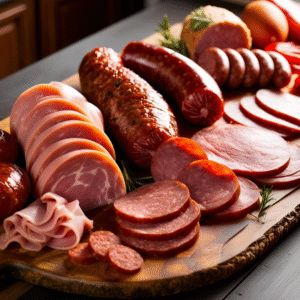1.1 What is Haemoglobin?
Haemoglobin is a protein in RBC (Red Blood Cells) that carries oxygen from your lungs to the rest of your body. It’s essential for energy and keeping your organs working well. There are different types of haemoglobin, like HbA in adults and HbF in babies, each doing a special job at different stages of life.
1.2 Why Haemoglobin Levels Drop
Low haemoglobin (or anemia) can happen due to health issues like kidney disease, blood loss, or bone marrow problems. Not getting enough iron, vitamin B12, or folate in your diet can also cause it. Even lifestyle choices like poor eating habits or heavy drinking can play a part.
1.3 Signs You Might Have Low Haemoglobin
Common symptoms include feeling tired, weak, pale, or out of breath. If these signs stick around, see a doctor to find out what’s going on and get the right treatment.
2. Eat Iron-Rich Foods to Boost Haemoglobin
2.1 Best Sources of Heme Iron (Animal-Based)

Our body easily absorbs Heme Iron and it is found in :
- Red meat (beef, lamb)
- Poultry (chicken, turkey)
- Fish (like tuna and salmon)
Grill, bake, or steam your food to keep the iron in.
2.2 Best Sources of Non-Heme Iron (Plant-Based)
Even though non-heme iron doesn’t absorb as well, it is still important for your body. Also, you can find it in many good food sources like…

- Lentils, chickpeas, beans
- Pumpkin seeds, almonds
- Spinach, kale
Eat these with vitamin C-rich foods (like oranges or bell peppers) to help your body absorb the iron better.
2.3 Using Iron Supplements Wisely
You can also consume iron supplements with your doctor’s advice if consuming food alone isn’t enough. Your doctor will help you choose the right type and dosage.
3. Get More Vitamin C to Help Absorb Iron
3.1 Why Vitamin C is Important
Vitamin C helps your body absorb iron from plant foods. Adults need around 75–90 mg a day.
3.2 Great Vitamin C Foods
Foods which are rich in Vitamin C:

- Fruits: Oranges, strawberries, kiwi, guava
- Veggies: Bell peppers, broccoli, Brussels sprouts
3.3 Smart Food Combos
Pair iron-rich and vitamin C-rich foods for better absorption, like:

- Spinach salad with orange slices
- Lentil soup and bell pepper sticks
- Stir-fried broccoli with beef
4. Other Nutrients That Help Haemoglobin
4.1 Folate
Red blood formation is aided by folate. Get it from:

- Leafy greens
- Beans and lentils
- Fortified cereals
4.2 Vitamin B12
Vitamin B12 is needed for increasing Haemoglobin content and is found in:

- Meat and fish
- Dairy products
Vegans and vegetarians may need supplements or fortified foods.
4.3 Copper and Other Minerals
Copper supports iron use which are found in:

- Shellfish
- Nuts and seeds
- Whole grains
Zinc and manganese also help, so eat a variety of foods.
5. Lifestyle Tips for Healthy Haemoglobin
5.1 Eat Smart
Include different iron-rich foods and skip coffee or tea with meals, as they block iron. Eat regularly and in balanced portions.
5.2 Stay Hydrated

To keep your blood healthy, first aim to drink at least 8 cups of water each day. Then, carry a water bottle and, if needed, set reminders to help you remember.
5.3 Check in with Your Doctor
Regular check-ups help you catch problems early. If you’re at risk for anemia, talk to your doctor about getting tested.
Final thoughts
Good haemoglobin levels are key to staying energetic and healthy. Eat well, stay hydrated, and get regular check-ups—small changes can make a big difference in how you feel!


